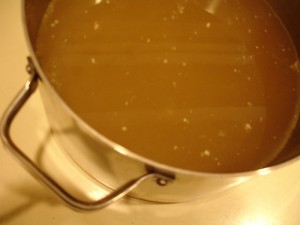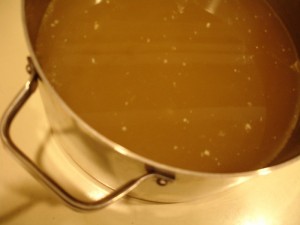 So many recipes require a good stock. Remember, you can add in vegetable scraps for extra flavor. Save scraps from trimming and scraping vegetables in a freezer bag and just keep adding. When you have a pound or so, boil them up and strain the liquid. Presto! Vegetable stock.
So many recipes require a good stock. Remember, you can add in vegetable scraps for extra flavor. Save scraps from trimming and scraping vegetables in a freezer bag and just keep adding. When you have a pound or so, boil them up and strain the liquid. Presto! Vegetable stock.
Here’s how to make meat stock.
It’s simple and rewarding to keep a supply of homemade beef and chicken stock in the freezer and once you have tasted it, you’ll never buy those bland cans of readymade broth or nasty bouillon cubes, again. And at this time of year, there’s nothing nicer than curling up on the sofa with a thick, homemade soup.
First: get the right equipment. The basics are a stockpot – a large covered pot, five or six quarts or larger, and preferably enamel on steel, although aluminum will do – and three or four large icecube trays, holding at least one ounce of fluid each. Chicken stock is the most versatile as it can be used in fish chowder and other fish dishes.
This method is the super deluxe way to make chicken stock. Most good cooks boil up the carcass after eating chicken, or freeze and save bones until there’s enough to use for a good amount of useable stock. That’s thrifty and smart. This way is the chef’s way – and it also yields a goodly amount of chicken meat for salads and pies.
Take two chickens. Toss the first chicken in the pot, including all the pieces that came stuffed inside – the liver, kidney, neckbone. The second also goes in the pot, but you might want to cut it up first, yielding two wings, two thighs, two drumsticks and two breasts, to broil or fry as a separate dish. The remainder – the rest of the carcass – goes in the soup pot.
Add enough water to come within three or four inches of the top of the pot. Throw in an onion or two, roughly chopped. Add one or two carrots and a couple stalks of broken-up celery, including the celery leaves, and three or four cloves of garlic you’ve mashed, but not peeled, with the flat part of a knife blade. A bay leaf, thyme, rosemary, a couple of shots of Italian seasoning – it’s your call. And remember a thrifty person saves all the vegetable scraps from previous meal preparations and freezes them in preparation of the stock-making process. That way there’s a big bag of “free” vegetables to add to the stock pot at this point.
Be ruthless with scum…
Turn the heat on high and watch carefully as the pot approaches the boil. At that point scum will start to rise to the top. Skim the scum. Be ruthless. You can always replace the water you’re taking out, as well as the flakes of seasoning. Fat will also begin to rise — skim it along with the scum. Eventually, once a smooth rolling boil is achieved, the rise of scum will stop. What you’ve removed also removes a source of a bitter aftertaste. The scum would have been reabsorbed into the stock if you had not begun skimming it the moment it began to rise.
Next, add more water and spices to replace what you skimmed. This is optional. Then maintain at a low simmer for about 45 minutes.
At this point remove the one or two chickens, or the whole chicken and the chicken back. Set aside until they are cool enough to handle, and then strip off the skin, tossing it back in the pot, and pulling all meat off the bone. Put the bones back in the pot and simmer everything for another hour.
In the meantime, portion out the meat you stripped. It’s boiled chicken, sure, but it’s delicious in sliced chicken sandwiches, chicken salad, or in chicken pies or chicken soups. What you cannot use immediately may be frozen. The stock should be ready. Get as many more pots as you need and pour off the liquid through a strainer into the new pots. Throw away the stuff in the strainer, and if you use the solids in the stockpot watch out for small bones.
To reduce it further, rinse out the stock pot, return the strained liquid to it, bring to a rolling boil and reduce by half (by boiling until the liquid is half as deep as it is now). This final reduction is optional. Either way, straight or reduced, a good way to preserve stock is to pour it into those ice cube trays and freeze them solid. Then transfer the stock cubes to freezer bags. Larger quantities of stock can be frozen in half-pint or pint containers. Now, when a recipe calls for one cup of stock, you can gather four stock cubes out of the freezer, add four ounces of water if it’s reduced stock, and there you have it. Instant broth!
Bully for you!
All of the above goes for beef stock, too. The major difference is that beef bones are harder to come by. Boiled beef is just not as tasty as boiled chicken. One thing to do is to save up beef bones whenever you have a steak or a roast, freeze them, and make a pot of stock when you have enough. Butchers at the supermarket will also sell you beef bones, which are not a bad investment if you use a lot of beef stock. Bon appetit!
